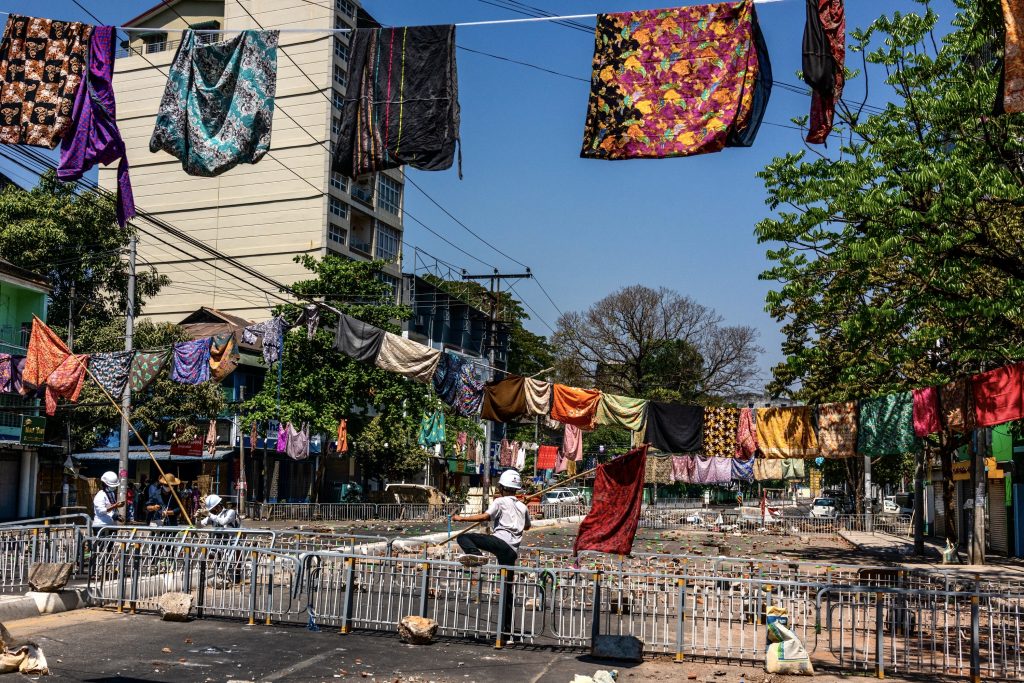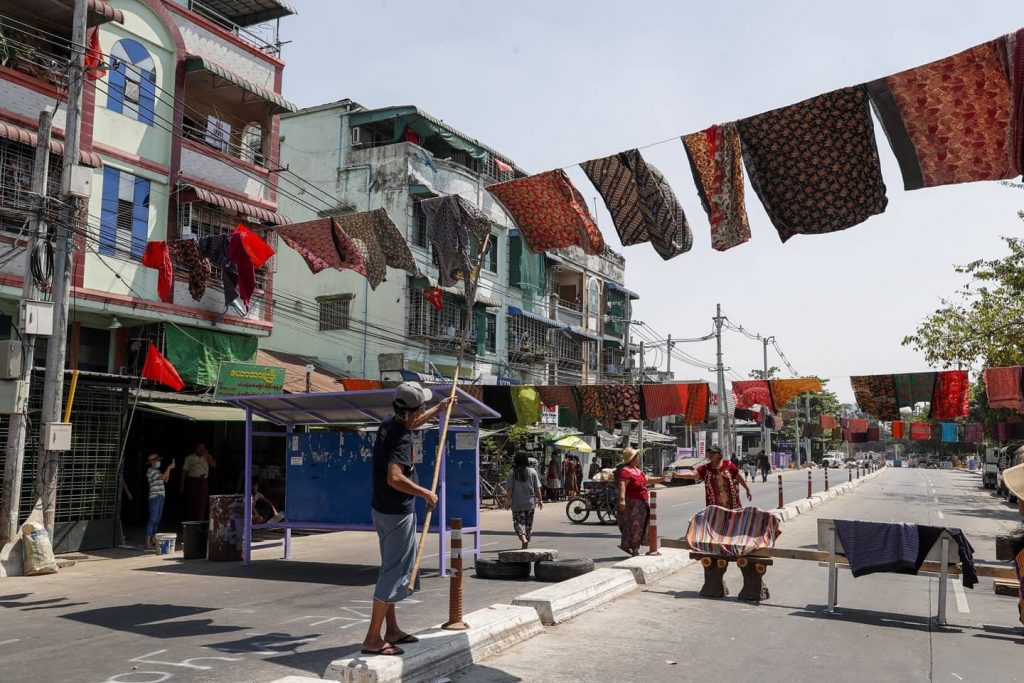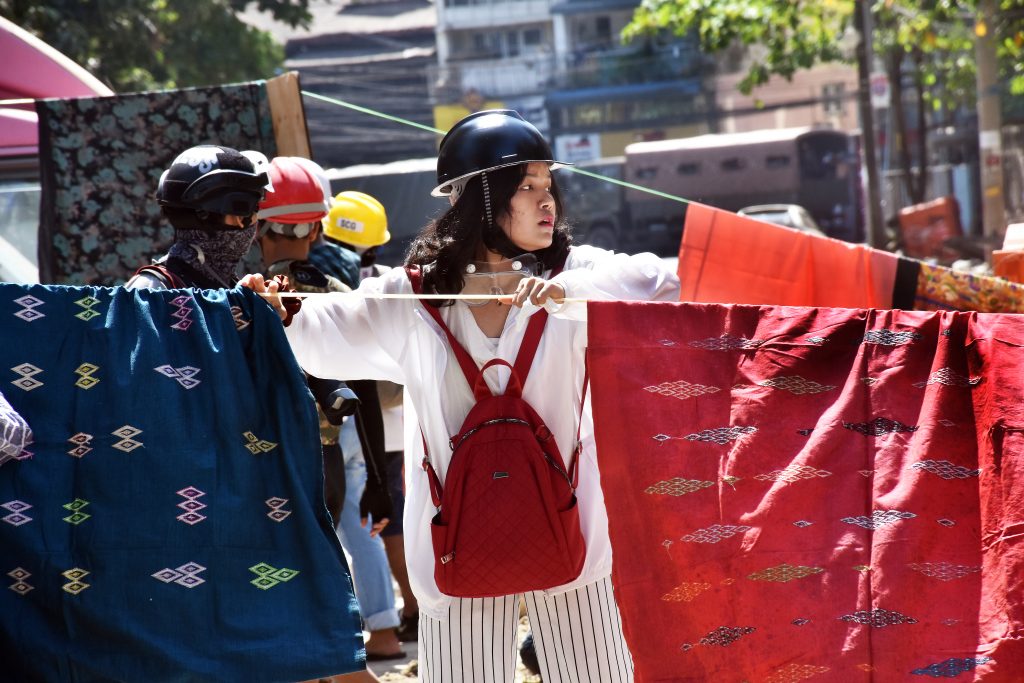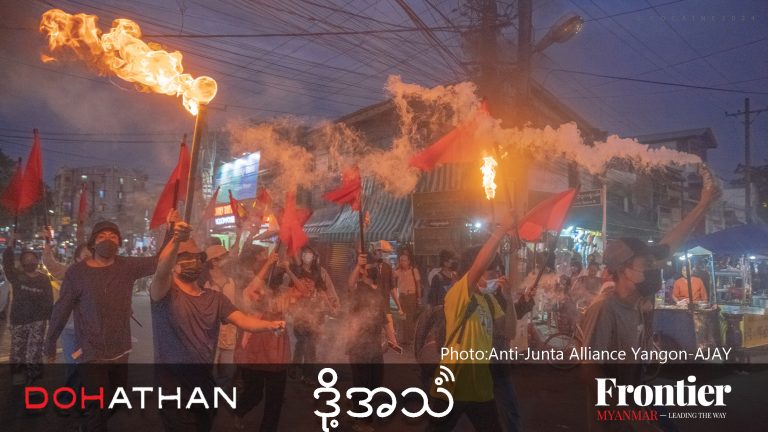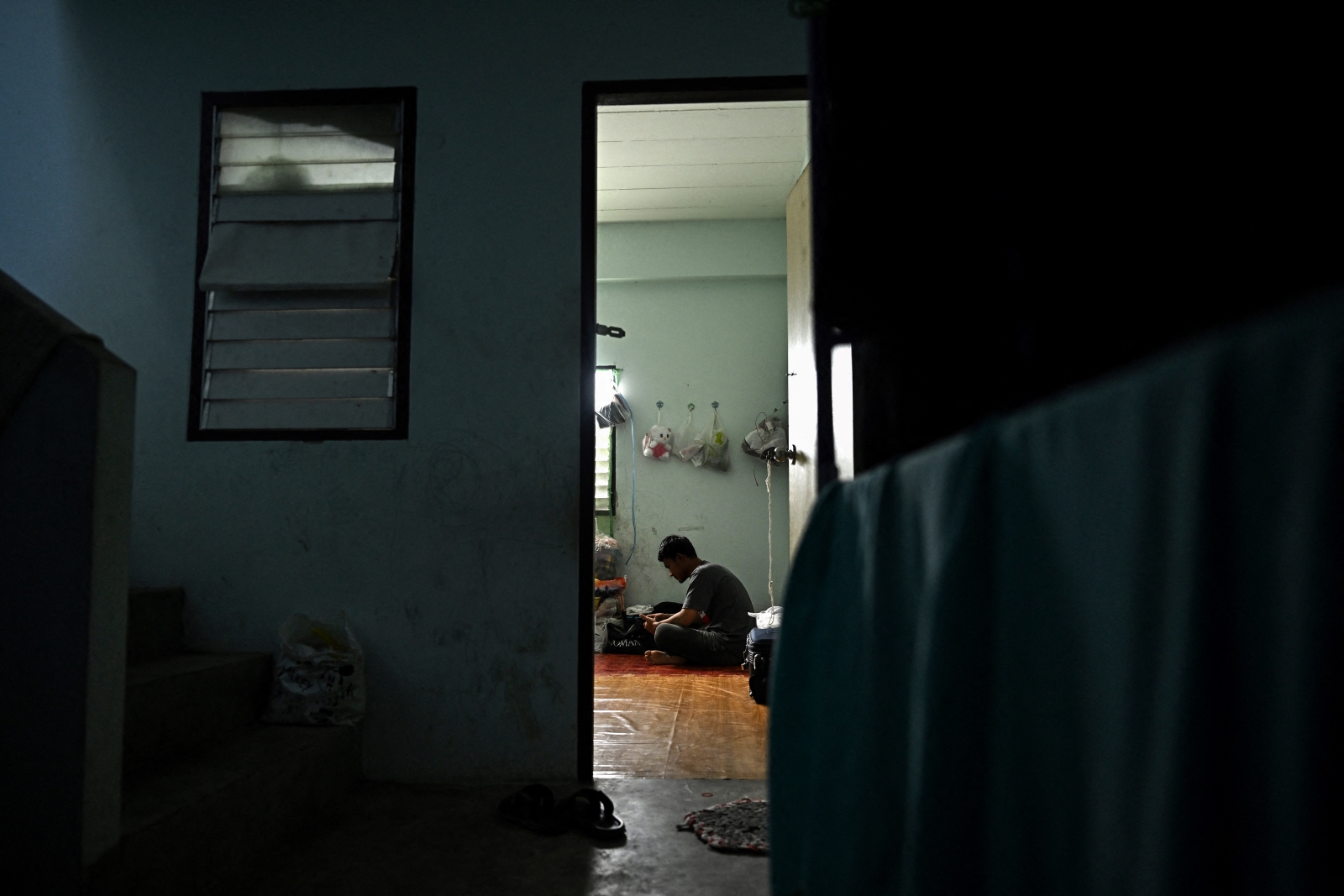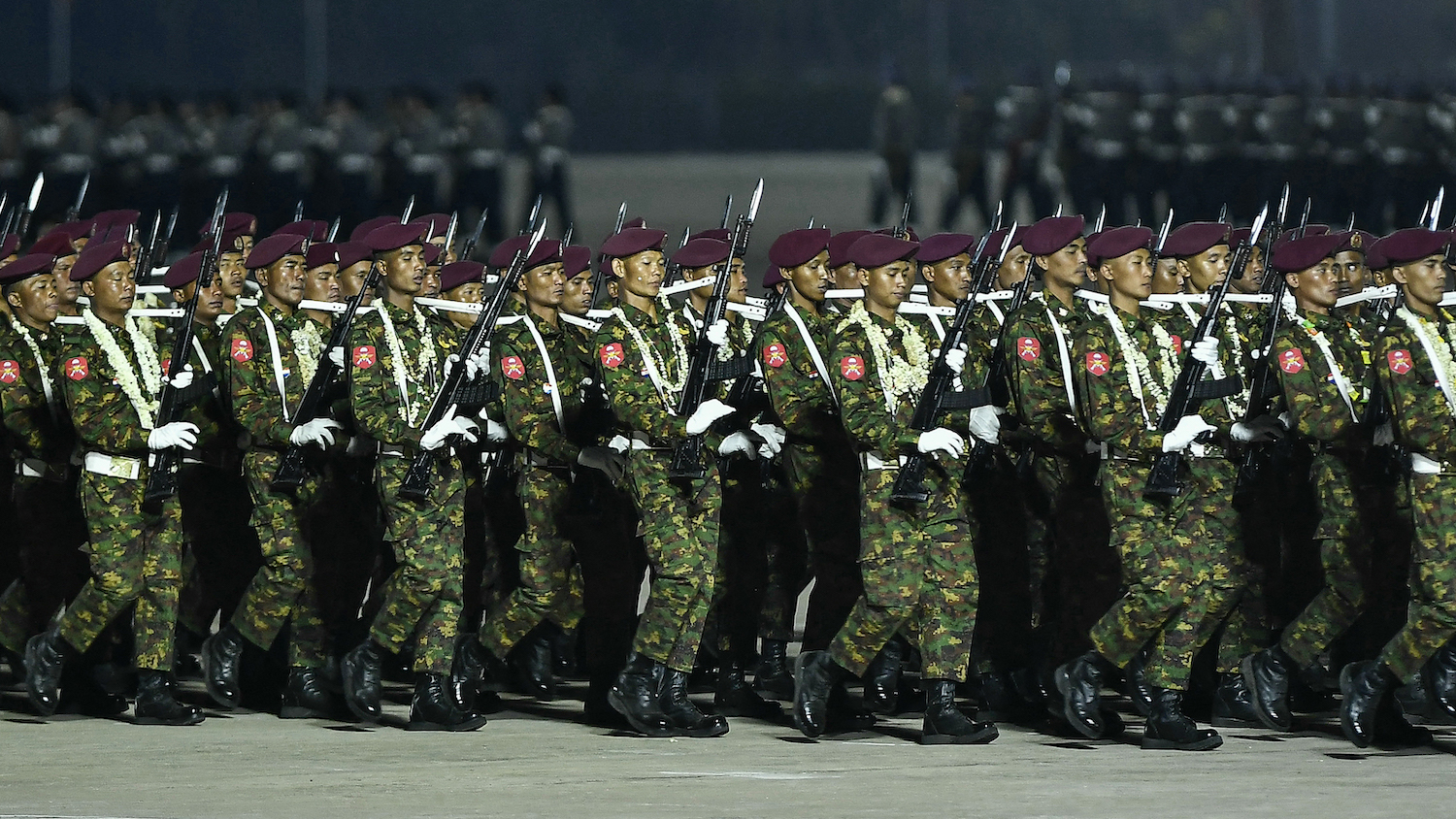Street protesters are using women’s clothing and even sanitary products to deter police and soldiers, weaponising the outdated belief that they can lessen a man’s power.
By FRONTIER
Before February 1, Thudhamma Road in North Okkalapa Township was one of the busiest roads in Yangon. Throughout the day and long into the night, container trucks, buses, light trucks, passenger vehicles, motorbikes and pedestrians all jostled for space on one of the main arteries from the inner suburbs to the city’s northern outskirts and beyond.
Since early on, Thudhamma has been an epicentre for protests. Tragically, this was the road where security forces gunned down eight young men on March 3. Yet even in the wake of that massacre, thousands of demonstrators have continued to protest each day against the military, bringing traffic to a standstill.
For most of the past month there has been little else on the road besides sandbags, rubbish bins, broken bricks, piles of tyres and lengths of huge PVC pipe more than a metre in diameter – all laid out to try and slow the advance of police and soldiers.
In recent days, however, a new weapon has been added to the protesters’ arsenal: htamein, a type of woman’s longyi or sarong. Countless colourful and visibly worn htamein have been attached on ropes hung across the road, from where they sway in the breeze, and sometimes women’s sanitary pads are hung along with them. Protesters say the strategy has been effective in significantly slowing down the security forces when they stage their regular crackdowns.
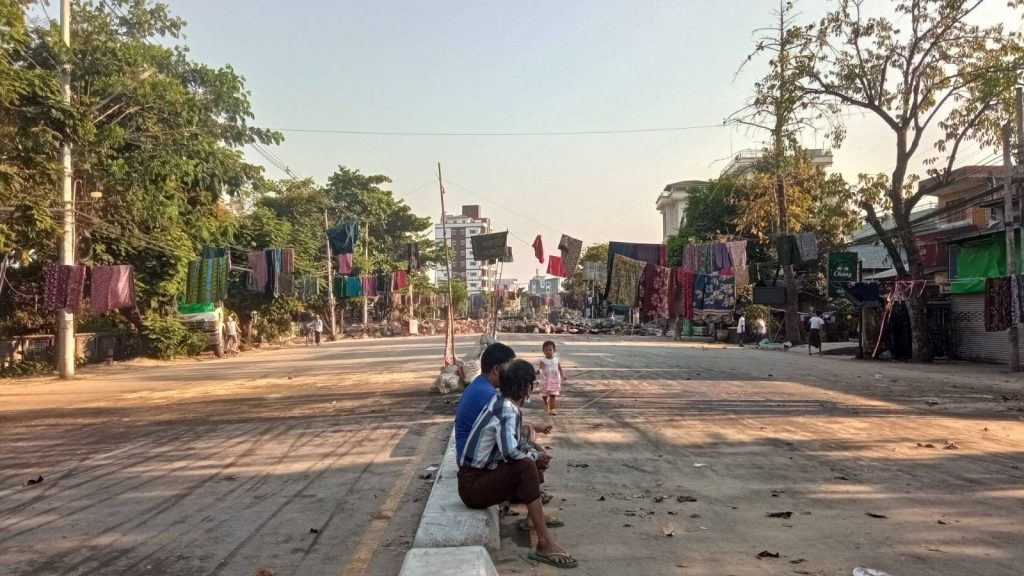
Htamein hang on Thudhamma Road in North Okkalapa Township. (Frontier) 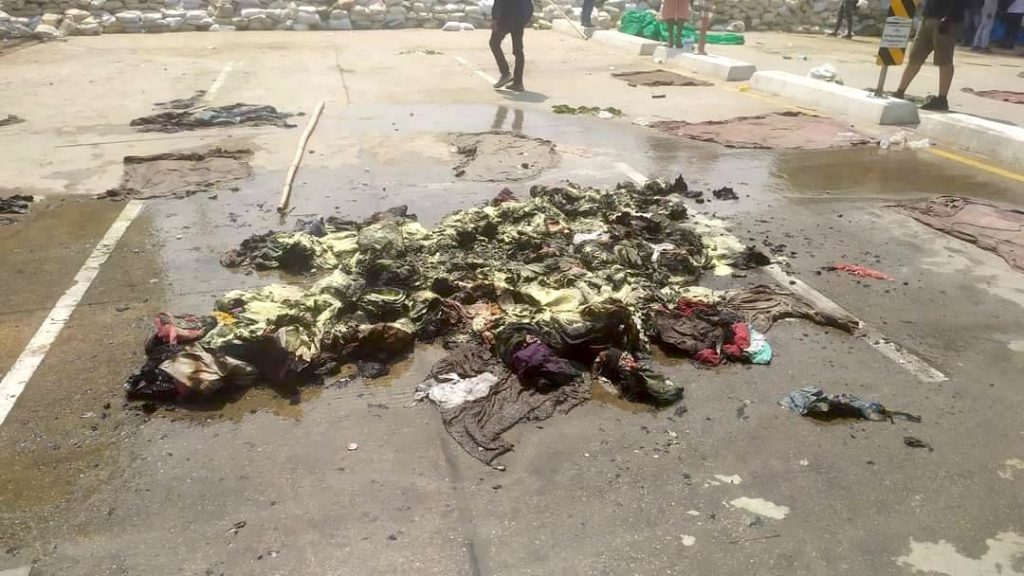
A pile of burned htamein on Thudhamma Road. (Frontier)
“The soldiers and police can come through the barriers. But when the htamein are hung above their heads, they don’t dare to enter,” said Ko Zaw Naing Myo, as he looked up at the garments hanging above his head.
The soldiers’ wariness to cross the lines of htamein and sanitary pads is due to a misogynistic belief held by many in Myanmar society, but particularly members of the male-dominated Tatmadaw, that a man’s pone – essentially their masculine power – is lessened if they come into contact with or pass beneath clothing that women wear on the lower part of their body.
Instead of crossing past the clotheslines, soldiers are taking time to remove the htamein, giving protesters more opportunity to find sanctuary in nearby homes.
“At least we can delay them. In my experience, they don’t dare come close to us without removing the htamein. They never go under it,” Zaw Naing Myo said.
The effect of this strategy is evident not only in North Okkalapa. Photos shared on social media from disparate locations appear to show authorities methodically removing the garments from clotheslines above the street before proceeding, prompting protesters to mock the authorities by shouting that they are “htamein thieves”.
Ruthless Myanmar security force is terrified to pass under women’s Longyi (sarong) as they believe this’ll cause them lose their ‘hpon’, spiritual power/male superiority. Longyi movement as a way of women’s resistance and fight against the dictatorship. #WhatsHappeningInMyanmar pic.twitter.com/L1SekyIr2e
— Khinny (@Khin_Khin_Mra) March 5, 2021
The tactic also helped protesters on Banyar Dala Road near Yuzana Plaza evade arrest on March 5 when police had them trapped in a pincer movement. Most managed to escape while the police pulled down and burned several rows of htamein, according to a Frontier reporter at the scene.
Once the police passed through the area, the protesters emerged and hung new rows of htamein even higher so that the police couldn’t reach them. Eventually, the police left the area.
Since then the campaign has spread quickly across the country and reached a crescendo on March 8, when activists held a “Htamein Revolution” to mark International Women’s Day. Demonstrators across the country hung htamein on clotheslines across streets and attached the garment to sticks to use as flags.
Among those who took part were members of the Federation of General Workers Myanmar, a group of industrial workers from Hlaing Tharyar Township, in western Yangon. Hundreds of its members marched in Hlaing Tharyar, holding aloft both the FGWM flag and their htamein flags.
“We have no weapons to harm them [police and soldiers], but anything that worries or delays them is our weapon,” said Daw Moe Sandar Myint, FGWM president.
Not every woman agrees with the campaign, however, underlining how deep-rooted this belief is in Myanmar society.
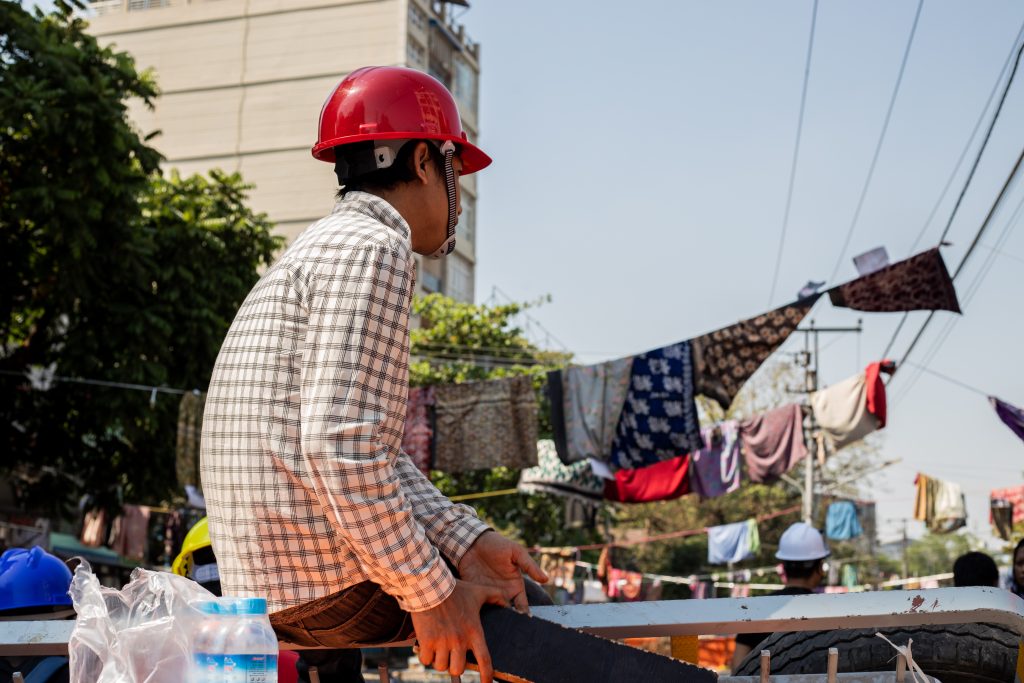
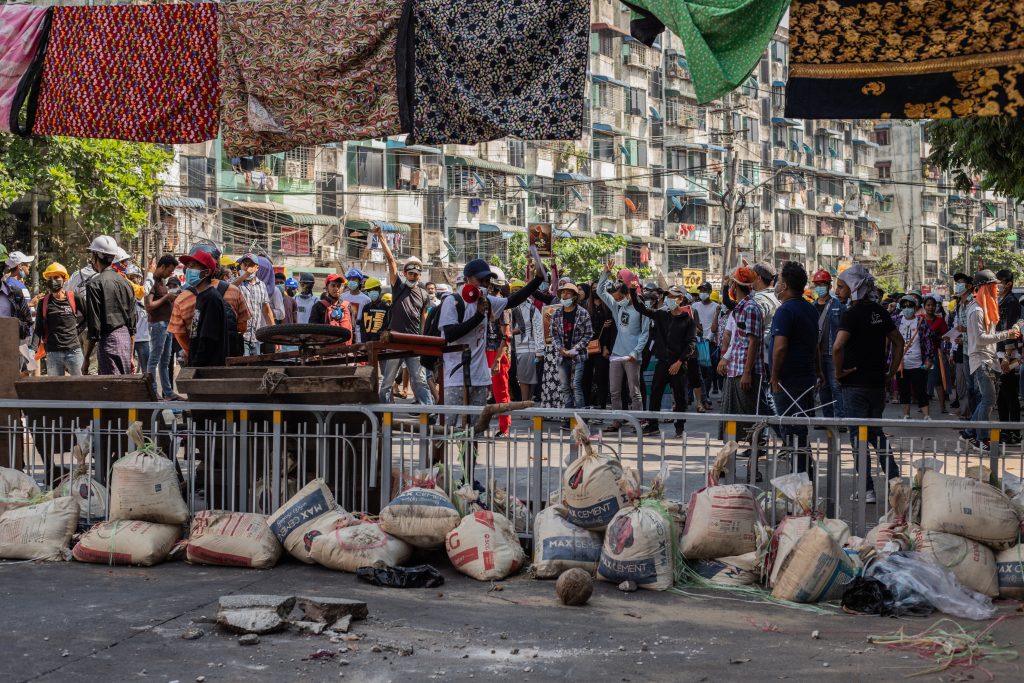
Unlike the security forces, most protesters seem unconcerned by the hanging htamein. (Frontier)
“The htamein is not something that should be hung in front of the house. It is about the shyness of Burmese women, and shows our respect to men,” said Daw Aye Khaing, 40, a resident of North Okkalapa.
The authorities do seem to be rattled by the tactic. After gathering the garments, police typically burn them on the road so they can’t be used again to slow them down. On March 8 seven protesters in Sanchaung Township were arrested for hanging htamein, while state media also threatened legal action against demonstrators hanging “women’s clothes and sanitary products” on the roads.
However, the Ministry of Information’s propaganda chief seemingly couldn’t face up to the fact that the womens’ clothes and sanitary pads were an effective strategy against superstitious soldiers, instead claiming implausibly that hanging the items constituted “deliberate acts to disrespect monks and tarnish Sasana”, the teachings of the Buddha.
The government has not confirmed which section it will use to charge the seven protesters, but said their arrest was due to “disrespecting Myanmar culture and amyo, batha and sasana”, or race, religion and Buddhist teachings.
The belief in the effect of women’s clothing on pone is based in part on a popular myth about King Duttabaung, founder of the ancient city of Sri Ketsra, near modern-day Pyay in Bago Region, in the fourth century BCE. According to the legend, which remains a common bedtime story in Myanmar, the king ransacked a neighbouring city and forcibly married a queen, Panhtwar. Unhappy about the marriage, the queen replaced her new husband’s face towel with her htamein. As a result, the story goes, he lost his pone, or power, and shortly after died in battle.
“The htamein of a woman who is not their mother terrifies the soldiers and the police. In particular, those on duty will avoid going under a htamein as much as possible,” said former police captain Moe Yan Naing, the whistleblower in the trial of Reuters journalists Ko Wa Lone and Ko Kyaw Soe Oo.
Moe Yan Naing was fired from the police force and spent nine months in prison for testifying that the police had set up the two journalists, and is now part of the anti-military movement in Sagaing Region.
In contrast, many male protesters do not appear to hold the traditional belief about htamein sapping their power. Ko Kyaw Swa Moe Thu, a demonstrator in North Okkalapa, said that while he believed in the concept of pone, he didn’t think that coming into contact with the garment could affect it. Like other protesters, he noticed the campaign had been effective in frustrating and slowing the police.
“So far, we can see they don’t want to come under the htamein, and it is really funny to look at them removing them. I think they believe that the htamein can degrade them,” he said.
Some men have even shown their support for the movement by posting photos on social media of them with htamein wrapped around their head.
“Glory does not dwell in clothes, but in humans,” Kyaw Swa Moe Thu said.
One feminist activist told Frontier that the protesters’ use of htamein to deter police and soldiers was helping to challenge and undermine these “degrading” beliefs rather than reinforce them.
“When I first saw the htamein hanging, I felt surprised and proud,” she said. “It is another victory that was born from the revolution.”


